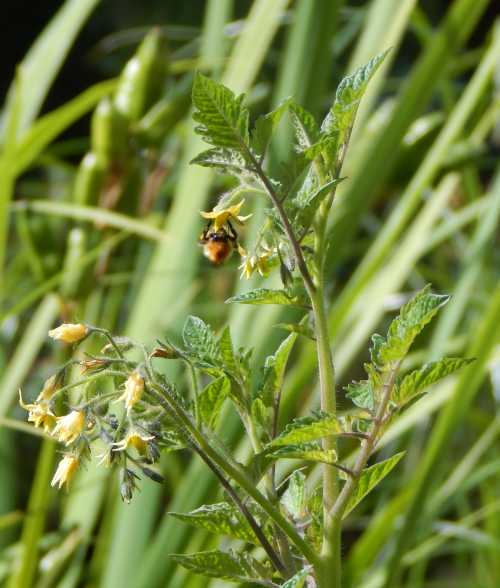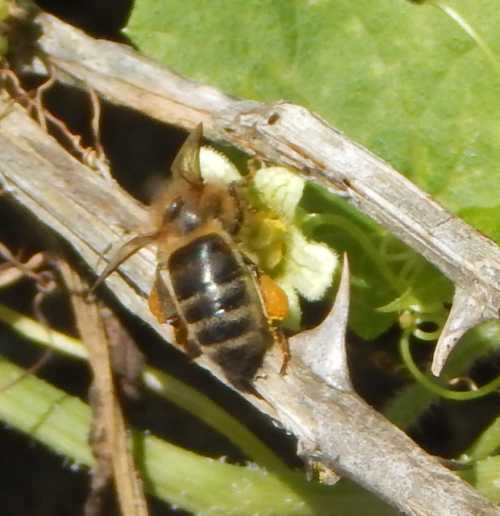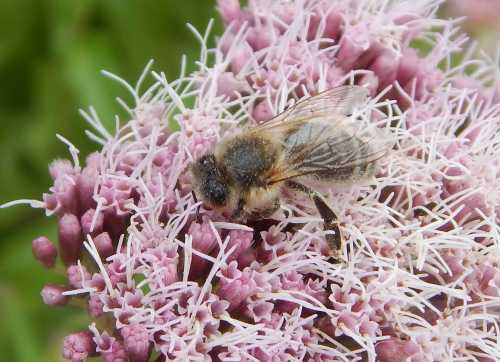Which Bees Can Buzz Pollinate?
Buzz pollination is a pollination syndrome in which bees use vibrations (sonification) to release pollen from flowers with specialized structures, especially 'poricidal anthers', which limit access to pollen rewards. After freeing the pollen from the anther, particles of pollen that land on the hair of the bee, are then transferred to the stigmas of other flowers, thus enabling pollination to occur.
In flowers with poricidal anthers, pollen is not freely accessible and legitimate access is restricted to bees capable of vibrating the anthers (buzz pollinating).
Which Bees Can Buzz Pollinate?
 Bumble bees are efficient pollinators of tomato flowers
Bumble bees are efficient pollinators of tomato flowersMore than half of all bee species can buzz pollinate1.
Bee species belonging to a number of bee genera in different bee families, are known to able to buzz pollinate (i.e. use sonification), and include (but are not limited to) the following:
| Family | Genus | Study |
|---|---|---|
| Apidae | Bombus (bumble bees) | Tayal et al (2001), King et al (2003), Buchmann et al (1985), Proenca (1992) |
| Xylocopa (large carpenter bees) | Tayal et al (2001), King et al (2003), Buchmann et al (1985), Proenca (1992). | |
| Exomalopsis | King et al (2003). | |
| Anthophora (flower bees) | Buchmann et al (1985). | |
| Amegilla | Proenca (1992). | |
| Epicharis | Buchmann et al (1985). | |
| Xenoglossa (squash bees) | Buchmann et al (1985). | |
| Centris (digger bees) | Buchmann et al (1985), Proenca (1992). | |
| Melipona (stingless bees) | Proenca (1992). | |
| Colletidae | Colletes (plasterer bees) | Buchmann et al (1985). |
| Ptiloglossa (plastere bees) | Buchmann et al (1985), Proenca (1992). | |
| Caupolicana (plasterer bees) | Buchmann et al (1985). | |
| Melittidae | Melitta (blunthorne bees) | Buchmann et al (1985). |
| Megachilidae | Megachile (leafcutter bees) | King et al (2003), Buchmann et al (1985). |
| Halictidae | Augochorella (sweat bees) | Buchmann et al (1985). |
| Augochlora (sweat bees) | Buchmann et al (1985). | |
| Augochloropsis (sweat bees) | Buchmann et al (1985), Proenca (1992). | |
| Nomia (sweat bees) | Buchmann et al (1985). | |
| Lasioglossum (sweat bees) | Buchmann et al (1985). | |
| Caenaugochlora (sweat bees) | Buchmann et al (1985). | |
| Pseudaugochlorpsis (sweat bees) | Buchmann et al (1985). | |
| Halictus (sweat bees / End-banded furrow bees) | Tayal et al (2001). | |
| Andrenidae | Protandrena (mining bees) | Buchmann et al (1985). |
| Mesoxaea (mining bees) | Buchmann et al (1985). | |
| Notoxaea (mining bees) | Buchmann et al (1985). | |
| Protoxaea (mining bees) | Buchmann et al (1985). |
Are bees that can buzz pollinate more efficient pollinators than other bee species?
I have read a number of scientific reports for a variety of bee species. So far, I have found that:
- Buzz pollination can be vitally important, or at least beneficial
It appears that 15,000–20,000 plant species only release pollen through the sonification method used by bees that are able to buzz pollinate1.
However, in the case of some of those plants, self-pollination will nevertheless result in fruits. Tomato plants, for example, will produce fruits without buzz pollination, but yield and quality may be improved when it occurs3 which is important for commercial growers. - Non-buzz pollinating bees can also be effective pollinators
It should be remembered that not all bees are able to buzz pollinate, yet for various reasons, are well adapted to pollinate certain flowers, and sometimes in particular agricultural conditions.
Honey bees cannot buzz pollinate, however, according to Wilson & Messinger Carril, authors of The Bees In Your Backyard, they are essential for almond pollination4.
Mason bees are excellent pollinators of fruits such as cherry, and following scientific trials, governments in some countries actively recommend farmers take steps to increase mason bees in orchards5. I have found no evidence that mason bees use sonification. - Buzz pollination can be affected by the environment, regardless of the efficiency of the pollinator.
For example, the buzz-pollinating stingless bee, Melipona quadrifasciata Le Peletier was found to be an efficient tomato pollinator, only when temperatures do not go above 28°C, because higher temperatures inhibit pollen production in tomatoes7.
Which bees are especially efficient at buzz pollination?
Looking at a variety of data sources, bumble bees (Bombus) and the large carpenter bees (Xylocopa) are repeatedly mentioned.
However, not all countries can take advantage of the pollination services offered by these species.
For example, there are no native bumble bee species in Australia, and importing them is seen to be problematic due to potential ecological impact1. Meanwhile, the use of Xylocopa species has been found to be difficult to rear for commercial greenhouse use8.
Is buzz pollination always beneficial?
Along with pollinating food crops, buzz pollination can be a double edged sword, depending on your view point! For example, bees engaging in buzz pollination may also be effective pollinators of 'weed' plants6.
However, the definition of a 'weed plant' can vary, and may nevertheless provide important food for other species.
Reference
1. Hazel Cooley, Mario Vallejo-Marín, Buzz-Pollinated Crops: A Global Review and Meta-analysis of the Effects of Supplemental Bee Pollination in Tomato, Journal of Economic Entomology, Volume 114, Issue 2, April 2021, Pages 505–519, https://doi.org/10.1093/jee/toab009.
2. Buchmann, Stephen L. “Bees Use Vibration to Aid Pollen Collection from Non-Poricidal Flowers.” Journal of the Kansas Entomological Society, vol. 58, no. 3, 1985, pp. 517–25, http://www.jstor.org/stable/25084671.
3. See my page about tomatoes for more information.
4. Wilson & Messinger Carril. The Bees In Your Backyard; Princeton University Press, 2016.
5. Please see my page about mason bees for further detail.
6. Tayal, M.; Kariyat, R. Examining the Role of Buzzing Time and Acoustics on Pollen Extraction of Solanum elaeagnifolium. Plants 2021, 10, 2592. https://doi.org/10.3390/ plants10122592
7. Hikawa, M., and R. Miyanaga. 2009. Effects of pollination by Melipona quadrifasciata (Hymenoptera: Apidae) on tomatoes in protected culture. App. Entomol. Zool. 44: 301–307.
8. Tamar Keasar, "Large Carpenter Bees as Agricultural Pollinators", Psyche: A Journal of Entomology, vol. 2010, Article ID 927463, 7 pages, 2010. https://doi.org/10.1155/2010/927463.
If you found this page helpful or interesting, I'd really be grateful if you would share it with others - if not this page, perhaps another, such as Gardening For Bees.
Thank you so much :) .

